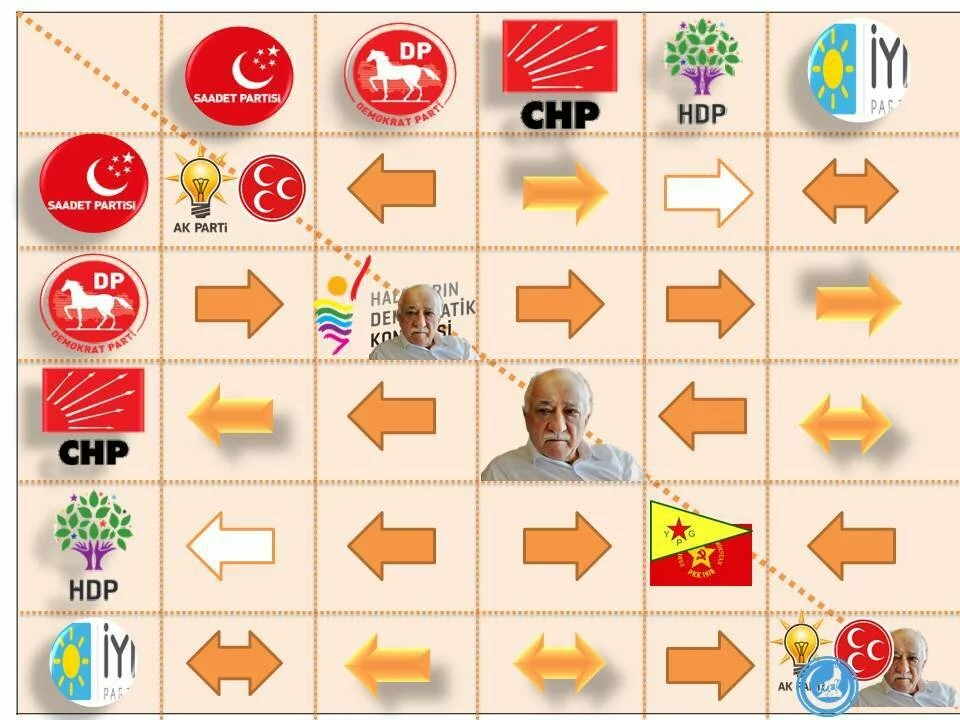NI1. ¿Partidos principales de la coalición opositora al gobierno de Erdogan?/ Main parties of the opposition coalition to the Erdogan government?

- ¿Cuáles son las principales ideologías de los partidos de la coalición opositora?/ What are the main ideologies of the parties of the opposition coalition?



- ¿Cuáles son las relaciones/vinculaciones entre los partidos de la coalición opositora? / What are the relations / links between the parties of the opposition coalition?






- ¿Cuáles son las relaciones/vinculaciones entre los partidos de la coalición opositora y países regionales y occidentales? / What are the relations / links between the parties of the opposition coalition and regional and western countries?



NI2. ¿Cuáles son los principales líderes de la coalición opositora al gobierno de Erdogan?/ Who are the main leaders of the coalition opposed to the Erdogan government?



- ¿Cuáles son las relaciones/vinculaciones ideológico-personales de los principales líderes de la coalición opositora? / What are the ideological-personal relationships / links of the main leaders of the opposition coalition?









Como podemos destacar en esta primera parte del análisis, se establecen dos ejes fundamentales:
Por un lado, el apoyo mutuo y necesario entre el principal grupo opositor e izquierdista (CHP) y el nuevo partido conservador IYI –que ha sumado la fuerza y el apoyo del partido kemalista DYP en favor de la candidata de IYI-. Este grupo comparte bases ideológicas y fundacionales del movimiento kemalista Fetullah, así como del partido Welfare (del que también parte el partido de Erdogan). La gran diferencia entre estos tres se encuentra en la relación con la cuestión kurda y las raíces más extremistas radicales otomanas del partido IYI. Es a través de IYI y el partido islamista SP (también con estrecha relación con los orígenes políticos de Erdogan), donde la principal fuerza opositora (CHP) puede lograr una ruptura electoralista entre los votantes descontentos con el partido de Erdogan (AKP) pero aún próximos a las líneas fundacionales del partido Welfare y la ideología Islamista-Nacionalista.
En la coalición, la fuerza principal (así como las oportunidades con las alianzas) recae sobre CHP, aunque la presentación individual a las elecciones nacionales de la candidata del partido IYI (que recibirá el apoyo de los contrarios a Erdogan y más pro-Occidentales) y el candidato del partido SP (que recibirá el apoyo de los descontentos con Erdogan pero de línea más continuista) dejará una disputa política entre las líneas más occidentalistas y aperturistas y los más continuistas y conservadores.
Sin duda alguna, la coalición opositora comparte una dirección política más regional, en favor de la pacificación con un acercamiento hacia el gobierno sirio, iraquí, saudí e iraní, además de recuperar el vínculo con la Unión Europea. El papel de Estados Unidos queda nublado por una Rusia más protagonista en los asuntos diplomáticos y una Europa fortalecida y protagonizada desde Alemania (contando con el amplio número de habitantes turcos en países europeos y por intereses económicos ante la importante crisis del país).
As we can highlight in this first part of the analysis, two fundamental axes are established:
On the one hand, the mutual and necessary support between the main opposition and leftist group (CHP) and the new conservative IYI party – which has added the strength and support of the DYP Kemalist party in favor of the IYI candidate. This group shares the ideological and foundational ideals of the Kemalist movement Fetullah, as well as the Welfare party (which also includes Erdogan’s party). The big difference between these three lies in the relationship with the Kurdish question and the more radical Ottoman roots of the IYI party. It is through IYI and the Islamist SP party (also closely related to the political origins of Erdogan), where the main opposition force (CHP) can achieve an electoral break between voters dissatisfied with the Erdogan party (AKP) but still next to the founding lines of the Welfare party and the Islamist-Nationalist ideology.
In the coalition, the main force (as well as the opportunities with the alliances) falls on CHP, although the individual presentation to the national elections of the candidate of the IYI party (which will receive the support of the opponents to Erdogan and of those more pro-Western) and the candidate of the SP party (which will receive the support of the discontented with Erdogan but with a more continuist line) will leave a political dispute between the most westernist and with open lines and the most continuist and conservative.
Without a doubt, the opposition coalition shares a more regional political direction, in favor of pacification with an approach towards the Syrian, Iraqi, Saudi and Iranian government, in addition to recovering the link with the European Union. The role of the United States is clouded by a Russia more protagonism in diplomatic affairs and a European Union strengthened -with Germany (counting on the large number of Turkish inhabitants in the European countries and the economic interests in the face of the country’s major crisis).
MARTA Gª OUTÓN
Solicitar informe de Inteliencia completo/ Ask for the full Intel report






